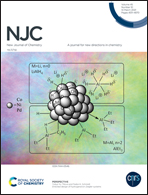Metal-free graphene-based nanoelectrodes for the electrochemical determination of ascorbic acid (AA) and p-nitrophenol (p-NP): implication towards biosensing and environmental monitoring†
Abstract
Herein, a metal-free tyramine-functionalized graphene oxide (T-GO) electrocatalyst was used for the electrochemical determination of ascorbic acid (AA) and an organic pollutant specially substituted by a phenolic compound, i.e., p-nitrophenol (p-NP), in 1 M phosphate buffer solution at pH 7 as a model species. The cyclic voltammetry investigation of AA and p-NP has a significant role in biosensing and the management of industrial waste. Thus, the electrochemical detection of AA and p-NP was successfully achieved using the T-GO-modified GC electrode for the oxidation of AA at an onset potential of −0.03 V vs. SCE. A redox reaction occurred for the detection of p-NP at an onset potential oxidation peak (O1) of 0.047 V vs. SCE and reduction peaks (R1 and R2) at −0.62 V vs. SCE and 0.147 V vs. SCE, respectively. The stability and reproducibility of the T-GO-based electrocatalyst were outstanding for the detection of both AA and p-NP, which can be attributed to its improved active surface area after the functionalization of GO with tyramine.



 Please wait while we load your content...
Please wait while we load your content...